new posts in all blogs
Viewing: Blog Posts Tagged with: nutrition, Most Recent at Top [Help]
Results 1 - 25 of 55
How to use this Page
You are viewing the most recent posts tagged with the words: nutrition in the JacketFlap blog reader. What is a tag? Think of a tag as a keyword or category label. Tags can both help you find posts on JacketFlap.com as well as provide an easy way for you to "remember" and classify posts for later recall. Try adding a tag yourself by clicking "Add a tag" below a post's header. Scroll down through the list of Recent Posts in the left column and click on a post title that sounds interesting. You can view all posts from a specific blog by clicking the Blog name in the right column, or you can click a 'More Posts from this Blog' link in any individual post.

By: Anna Shannon,
on 10/16/2016
Blog:
OUPblog
(
Login to Add to MyJacketFlap)
JacketFlap tags:
Books,
parenting advice,
child nutrition,
infant health,
Nutrition for Developing Countries,
Nutrition for Developing Countries Third Edition,
baby development,
baby Nutrition,
care group,
first 1000 days,
Jennifer N. Nielsen,
pregnancy nutrition,
motherhood,
parenting,
child development,
nutrition,
pregnancy,
Pediatrics,
*Featured,
Science & Medicine,
Health & Medicine,
Ann Burgess,
1000 days,
Add a tag
Nowadays we use the term ‘first ‘1000 days’ to mean the time between conception and a child’s second birthday. We know that providing good nutrients and care during this period are key to child development and giving a baby the optimum start in life.
The post The first 1000 days appeared first on OUPblog.

By: William Bocholis,
on 9/30/2016
Blog:
OUPblog
(
Login to Add to MyJacketFlap)
JacketFlap tags:
bread,
diabetes,
healthy diet,
*Featured,
oxford journals,
cancer prevention,
Health & Medicine,
american institute for cancer research,
Nutrition Reviews,
dietetics,
Niyati Parekh,
Nour Makarem,
whole grain,
Journals,
obesity,
cancer research,
nutrition,
Add a tag
An emerging field in the area of nutrition and cancer is the role of whole grains in cancer prevention. In a world where carbohydrates, particularly refined sources, are increasingly viewed as the culprit for obesity and associated chronic disease, are whole grains the safest carbohydrate to recommend for cancer prevention? Currently, consuming a plant-based diet containing whole grain foods is part of the American Cancer Society
The post Whole grains for cancer prevention? Take the evidence with a grain… of salt appeared first on OUPblog.

By: Simon Turley,
on 7/25/2016
Blog:
OUPblog
(
Login to Add to MyJacketFlap)
JacketFlap tags:
Journals,
nutrition,
brain,
pregnancy,
alzheimer's disease,
*Featured,
oxford journals,
Science & Medicine,
Health & Medicine,
malnutrition,
Psychology & Neuroscience,
A Journal of Neurology,
brain size,
Dutch Famine,
prenatal famine exposure,
prenatal health,
Susanne de Rooij,
undernutrition,
Add a tag
The importance of a healthy diet for proper functioning of the brain is increasingly being recognized. Week in, week out studies appear recommending a high intake of certain foods in order to achieve optimal brain function and prevent brain diseases. Although it is definitely no punishment for the most of us to increase our chocolate consumption to boost brain function, the most important period during which nutrition affects our brain may already be behind us.
The post The lifelong importance of nutrition in pregnancy for brain development appeared first on OUPblog.

By: Kathleen Sargeant,
on 4/10/2016
Blog:
OUPblog
(
Login to Add to MyJacketFlap)
JacketFlap tags:
*Featured,
Business & Economics,
European Review of Agricultural Economics,
Adélaïde Fadhuile,
animal products,
animal-based foods,
carbon reduction,
carbon tax,
diet sustainability,
environmental fiscal policies,
ERAE,
France Caillavet,
GHG emissions,
oxford journals,
Greenhouse Gas Emissions,
global food system,
purchasing behaviours,
Véronique Nichèle,
Journals,
environment,
nutrition,
sustainability,
Add a tag
The global food system is estimated to contribute 30% of total Greenhouse gas (GHG) emissions. In this context, the EU has committed to reducing GHG emissions by 40% relative to 1990 levels by 2030 and by 80% by 2050. Apart from the necessary policies of citizen information and production regulation, could a consumer tax on the most Greenhouse gas-emitting foods be a relevant tool to improve diet sustainability? Could it combine greener and healthier diets with a limited social cost?
The post Could a tax on animal-based foods improve diet sustainability? appeared first on OUPblog.

By: DanP,
on 1/7/2016
Blog:
OUPblog
(
Login to Add to MyJacketFlap)
JacketFlap tags:
The Double Helix with Dawn Field,
health,
science,
biology,
new year's resolutions,
diet,
nutrition,
microbes,
DNA,
genes,
healthy eating,
bacteria,
genomes,
paleo,
atkins diet,
life sciences,
Biocode,
Processed Meat,
Dan Field,
DNA diet,
microbiomes,
Books,
*Featured,
Science & Medicine,
Earth & Life Sciences,
Add a tag
2016 is here. The New Year is a time for renewal and resolution. It is also a time for dieting. Peak enrolment and attendance times at gyms occur after sumptuous holiday indulgences in December and again when beach wear is cracked out of cold storage in summer. As the obesity epidemic reaches across the globe we need new solutions. We need better ways to live healthy lifestyles.
The post We should all eat more DNA appeared first on OUPblog.

By: Lizzie Furey,
on 11/9/2015
Blog:
OUPblog
(
Login to Add to MyJacketFlap)
JacketFlap tags:
nutrition,
public health,
world health organization,
Nutrition Review,
Sarah Zimmerman,
anemia,
iron,
*Featured,
Health & Medicine,
Food Fortification,
fortified flour,
fortified foods,
Helena Pachón,
Add a tag
Two studies published this year yield conflicting results on whether fortifying flour with essential vitamins and minerals improves anemia prevalence. One study published in the British Journal of Nutrition (BJN) showed that each year of flour fortification was associated with a 2.4% decrease in anemia prevalence among non-pregnant women.
The post Can flour fortification programs reduce anemia? appeared first on OUPblog.

By: Bridget Stokes,
on 10/16/2015
Blog:
OUPblog
(
Login to Add to MyJacketFlap)
JacketFlap tags:
Books,
health,
food and drink,
nutrition,
Food & Drink,
coca-cola,
Marion Nestle,
public health,
Infographics,
pepsi,
american food and drink,
*Featured,
Health & Medicine,
Soda Politics,
Taking on Big Soda (and Winning),
soda industry,
sugary drinks,
Add a tag
Although soda companies such as Coca-Cola and PepsiCo are recognized around the world - the history, politics, and nutrition of these corporations are not as known. In her latest book, Soda Politics: Taking on Big Soda (and Winning), Marion Nestle exposes the truth behind this multi-billion dollar industry. Check out these hard hitting facts and see how much you actually know about the soda industry.
The post The soda industry exposed [Infographic] appeared first on OUPblog.

By: Elizabeth Gorney,
on 5/14/2015
Blog:
OUPblog
(
Login to Add to MyJacketFlap)
JacketFlap tags:
Books,
depression,
diet,
nutrition,
mood,
*Featured,
Science & Medicine,
Health & Medicine,
Psychology & Neuroscience,
Gary L. Wenk,
chronic obesity,
Add a tag
Considerable evidence has linked an unhealthy diet to obesity, metabolic syndrome, diabetes and cancer. We now understand how chronic obesity ages us and then underlies the foundation of our death. Furthermore, obesity leads to body-wide chronic inflammation that predisposes us to depression and dementia. However, these are all the long-term consequences of our diet upon our body and brain.
The post How does food affect your mood? appeared first on OUPblog.

By: Meredith Sneddon,
on 1/26/2015
Blog:
OUPblog
(
Login to Add to MyJacketFlap)
JacketFlap tags:
Books,
immigration,
smoking,
Multimedia,
nutrition,
nursing,
public health,
violence prevention,
Emigration,
*Featured,
Science & Medicine,
Health & Medicine,
medical publishing,
Ebola,
vape,
electronic cigarettes,
Add a tag
Last year was an important year in the field of public health. In 2014, West Africa, particularly Sierra Leone, Liberia, and Guinea, experienced the worst outbreak of the Ebola virus in history, and with devastating effects. Debates around e-cigarettes and vaping became central, as more research was published about their health implications. Conversations surrounding nutrition and the spread of disease through travel and migration continued in the media and among experts.
We’ve chosen a selection of articles that discuss public health issues that arose in 2014, their effects on the present and implications for the future.

Header image: US specialist helping Afghan nomads by Sfc. Larry Johns (US Army). Public domain via Wikimedia Commons.
The post Public health in 2014: a year in review appeared first on OUPblog.


By:
Robin Brande,
on 11/13/2014
Blog:
Robin Brande
(
Login to Add to MyJacketFlap)
JacketFlap tags:
Inspiration,
Nutrition,
Vegetarian,
How To,
Vegan,
Acne,
Acne Advice,
Acne Cures,
Adult Acne,
Benefits of Vegan Diet,
Causes of Acne,
Curing Acne with Diet,
Curing Adult Acne,
Dietary Fat and Acne,
Dr. John McDougall,
Dr. McDougall,
Fat and Acne,
Low-Fat Vegan,
Low-Fat Vegan Diet,
McDougall diet,
Nina and Randa,
Nina and Randa Nelson,
Vegan Diet,
Add a tag
It’s been a long time since I had acne. Thankfully. Because I had severe cystic acne–the kind that looks like open sores all over your face and chest and back–all through college and well into my late 20s. I think I saw the last of it when I was 29, and that was only after two full rounds of Accutane. Accutane is some scary stuff. I had to sign all sorts of waivers and promises to stay on birth control because the drug causes horrible birth defects. Over the course of the two years I used it, I couldn’t wear contacts because my eyeballs dried out. I had to put lotion on every inch of my skin several times a day because it was all so parched and flaking. I felt itchy and sore. But yes, the drug finally worked. And I was incredibly grateful.
Which is why I’m posting this video. Because if I had known when I was younger what Randa and Nina have discovered, I would have changed my diet right away. Acne like the kind they and I had destroys your self-confidence and makes you want to crawl into a hole and not let the world see you. And in my case, unlike theirs, I was also obese in college, so between that and the acne, you can imagine I wasn’t really enjoying my 20s.
If I could go back to the young woman I was and whisper in her ear, “Hey! Look at this!” I would. But until I’ve worked out all the mechanics of time travel, the best I can do is to help any of you who might be suffering from the same problem. Because it is suffering–I know that too well.
Best of luck to all of you! And thanks Nina and Randa for sharing your story and your pictures. I know that was hard!
.jpeg?picon=3498)
By: Cait,
on 9/25/2014
Blog:
Cait's Write...
(
Login to Add to MyJacketFlap)
JacketFlap tags:
tips,
running,
motivation,
art,
goals,
nutrition,
injuries,
training,
cross training,
Add a tag
Within every runner live the Yin Yang twins…the grinder and the ice-cream loving, sloth who lives to watch cartoons. We’ll call the latter the ‘recovery champ’.

While I jest, because it’s not just ice cream they love but pizza, donuts, burritos, french toast [insert runger fantasies here], there is truth to it.
In order to run hard you’ve got to allow your body to recover just as ‘hard.’ It often takes runners awhile to learn this, often the hard way. Typically everyone goes through the stage where they race every run, a run doesn’t count unless you’ve maxed out, right?!  While this usually leads to improvement in the short term, eventually going hard every day will lead down the road of an injured, over-trained, mess.
While this usually leads to improvement in the short term, eventually going hard every day will lead down the road of an injured, over-trained, mess.
Without adequate recovery you’ll be too tired to actually run fast. Easy days are important, as are other ways to speed up your recovery. In order to NAIL the days that count, your hard workouts and races, you’ve got to ensure your muscles are able to rebuild and repair themselves between hard sessions.
So there IS an excuse to laze around in your sweats and hit up a Netflix marathon.  Recovery is more than just an easy day too, for most mortal runners of the world running isn’t your job so lifestyle choices and how you spend the non-running hours of your day will play a big role in your ability to recover.
Recovery is more than just an easy day too, for most mortal runners of the world running isn’t your job so lifestyle choices and how you spend the non-running hours of your day will play a big role in your ability to recover.
Even for the elite runners, they are continually looking for ways to improve their recovery…because chances are there is ALWAYS room for improvement somewhere.
Take a look at your own habits and look for areas you know you could be better at. I’ve made a handy little checklist to give you some ideas of where to start:
* Make sure your easy days COUNT: rely on effort, don’t wear a watch if you have to, you should be able to hold a conversation between breathes on these runs.
* Proper Workout Scheduling: every runner needs to learn their body and how many hard workouts they can handle in a week. As we age we need to learn how to adjust, that may mean turning your ‘week’ into a 10 day cycle.
* Cross Training: I did a whole post HERE about how to maximize training if you know your body can’t handle too many running miles. Cross training on your easy days or as a ‘second run’ can help keep you healthy and allow for an ‘easier’ workout for recovery purposes.
* 30 Minute Refuel: eat a combo of protein and carbs IMMEDIATELY after your runs…especially your hard workouts. Miss this window and recovery rates drop upwards of 60%.
* Nutrition: eating to perform means opting for quality foods, timing them around when you run, and ensuring you get enough nutrients. This means protein, carbs, healthy fats, and overall enough calories to fuel your training demands. Eating to perform also means LIVING, if you’re training hard enough and want a freaking donut, you’ve earned it. Balance comes into play, so I’ll use the analogy of a silo. Fill your body with all the quality nutrients first, then any extra ‘energy demands’ needed to fill the rest of the silo should be up to you. A world without french toast is a dark one.
* Self massage: whole post on that HERE, flush out that lactic acid, keep your body knot-free.
* Hydrate: this is incredibly important regardless of the season, obviously hotter weather requires you to hydrate more and with electrolytes but even in a snow storm you’re losing moisture. Drinking after massage is also important to flush out all that ‘junk’ worked out of your muscles.
* Stretching: tied into self-massage, stay loose, limber, and avoid injuries.
* Time on Your Feet: it’s draining on your legs and energy-zapping, if your job requires you to do lots of ‘work’ know that you may need to adjust your training or learn how it affects you.
* Time on your butt: yea it’s important to rest, BUT office jobs can lead to problems too…too much sitting leads to weak glutes, tight hamstrings, and reduced blood flow. Not good for recovery, so be sure to move around and at least walk around a bit between Netflix marathons.
* Sleep: while I may leave this one for last, this is HUGE!! Sleep is when the body REALLY restores and repairs itself. Skimping on sleep will hamper your recovery, professional runners guard their sleep time and usually take naps too. Make sleep a priority. For those with sleeping problems and insomnia (ugh, join the party!) look for ways to improve the situation or figures out what can sometimes help. Restless nights add up to tired legs and eyebags. 
I think that’s a solid list of ways to improve your recovery habits. Start cracking! To let that grinder perform at it’s best, that recovery-er needs to be doing it’s job right too! 
—–
New ART is listed and available for prints on my page there…restructured to make things a little easier. As always, anything not shown, email me a request and I’ll get you a print.
—-
1) What are some ways you make recovery a priority?


By: ChloeF,
on 8/1/2014
Blog:
OUPblog
(
Login to Add to MyJacketFlap)
JacketFlap tags:
sport,
athletes,
nutrition,
cheating,
VSI,
hormones,
Very Short Introductions,
milk,
Editor's Picks,
*Featured,
Science & Medicine,
Health & Medicine,
doping,
Sports & Games,
colostrum,
food supplement,
food supplements,
Martin Luck,
performance enhancing,
wada,
Add a tag

By Martin Luck
A recent edition of BBC Radio 4′s On Your Farm programme spoke to a dairy farmer who supplies colostrum to athletes as a food supplement.
Colostrum is the first milk secreted by a mother. Cow colostrum is quite different from normal cow’s milk: it has about four times as much protein, twice as much fat, and half as much lactose (sugar). It is especially rich in the mother’s antibodies (IgG and IgM), providing the newborn calf with passive immunity before its own immune system gets going.
People who take colostrum believe it has health and performance benefits. It’s said to reduce muscle recovery time after intense training, maintain gut integrity against the heat stress of exercise, and assist recovery from illness and surgery. The radio programme spoke to cyclists, rugby players, footballers, runners, and others convinced of its value and who are prepared to pay the significant premium which colostrum commands over ordinary milk.
Unfortunately, the scientific evidence for these effects is rather poor, especially on the health side. Nutritional and clinical scientists who have reviewed the research literature report a lack of well-designed and reliable trials. There is some evidence for enhanced speed and endurance and for increased strength in older people undertaking resistance training, but many studies show equivocal or unconvincing results. So for the moment, it’s probably safest to describe the benefits of colostrum consumption as anecdotal.
Colostrum undoubtedly contains some hormones and growth factors in higher amounts than in normal milk. Levels of insulin and IGF-1 can be eight times higher in colostrum, especially during the first few hours after calving. Growth hormone is also present at this time, and disappears later. Other hormones, including prolactin, cortisol, vitamin D and a range of growth factors (hormones controlling cell division and maturation), also occur at relatively high amounts in colostrum.

Colostrum cakes
These hormones all have well known biological effects in the body, but finding them in colostrum doesn’t necessarily mean that they will be active when it is consumed in the diet. There are two main reasons for this. Firstly, protein hormones like insulin and IGF-1 get broken down in the gut and are unlikely to be absorbed in an active state. (If the reverse were true, diabetics could take insulin in pill form rather than injections.) Secondly, naturally-secreted hormones generally work in concentration-related ways, appearing in the blood as repeated pulses with which their receptors become coordinated. This pattern is unlikely to be replicated by pouring colostrum over the breakfast cornflakes.
Nevertheless, the possibility that colostrum is a source of potentially performance enhancing bioactive materials has been considered by the World Anti-Doping Agency. Many hormones and growth factors including insulin, IGF-1, cortisol and Growth Hormone, appear in their list of prohibited substances. So could colostrum make athletes fall foul of the regulations? The WADA website advises that although colostrum is not banned, its growth factor content “could influence the outcome of anti-doping tests” and its consumption is not recommended.
Aside from efficacy, colostrum poses a wider, ethical question: when does a natural food product become an artificial supplement? At one extreme, it might be feasible to extract the active ingredients and take them as a training aid or performance enhancer. At the other, perhaps as recognised by WADA, one might happen to consume colostrum as a food without intending to benefit unduly from it. Somewhere in between would be the deliberate consumption of colostrum knowing that it contains potentially beneficial components.
But then why is that different from, say, increasing ones intake of protein or energy to support a higher level of athletic performance? Neither whey protein nor glucose, nor for that matter caffeine or bananas, appear in WADA’s prohibited list, yet they all have their place in the training and performance regimes of many athletes and sports men and women.
Identifying hormones as discrete, potentially bioactive chemical components of food seems to encourage the drawing of a false line along this continuum. No one condones cheating or the gaining of unfair advantage, but it is not clear why one food product should be restricted when another is not, especially when it is available to all and has no identified side effects.
But this brings us back to the question of efficacy? Does colostrum really work? If it could be shown that it does and if it were made widely available as a food item, there is no doubt that all athletes would use it. This might make the doping authorities review their position, although it could mean, of course, that no one is really advantaged (just as being tall brings no gain when playing basketball against others selected for their height).
To find out if colostrum really does work, many more well-designed, high quality, double blind placebo-controlled trials would be necessary. Such investigations are expensive and difficult and few organisations will have the expertise or resources to devote to something which, as a completely natural product, is unlikely to bring commercial gain. But this is the problem with many food supplements and so-called superfoods (and partly explains why health food shops abound in the high street).
In the end, people use food supplements because they believe them to work, not because there is much reliable evidence that they do. And perhaps this, in turn, means that there is no legitimate reason for banning their use.
Based at the University of Nottingham as a Professor of Physiological Education, Martin Luck is the author of Hormones: A Very Short Introduction. He was awarded a National Teaching Fellowship by the Higher Education Academy in 2011.
The Very Short Introductions (VSI) series combines a small format with authoritative analysis and big ideas for hundreds of topic areas. Written by our expert authors, these books can change the way you think about the things that interest you and are the perfect introduction to subjects you previously knew nothing about. Grow your knowledge with OUPblog and the VSI series every Friday, subscribe to Very Short Introductions articles on the OUPblog via email or RSS, and like Very Short Introductions on Facebook.
Subscribe to the OUPblog via email or RSS.
Subscribe to only science and medicine articles on the OUPblog via email or RSS.
Image credit: Colostrum cakes, by Surya Prakash.S.A., CC-BY-SA-3.0 via Wikimedia Commons
The post Colostrum, performance, and sports doping appeared first on OUPblog.


By: ChloeF,
on 6/6/2014
Blog:
OUPblog
(
Login to Add to MyJacketFlap)
JacketFlap tags:
marketing,
Food,
packaging,
nutrition,
VSI,
Food & Drink,
Very Short Introductions,
labelling,
supermarket,
pineapple,
*Featured,
Health & Medicine,
5-a-day,
David Bender,
food group,
superfoods,
servings,
Add a tag

By David A. Bender
The food pyramid shows fruits and vegetables as the second most important group of foods in terms of the amount to be eaten each day: 3-5 servings of vegetables and 2-4 servings of fruit. This, and the associated public health message to consume at least 5 servings of fruit and vegetables a day, is based on many years of nutritional research. Fruits and vegetables are rich in vitamins and minerals, as well as many other potentially protective compounds, and low in fat (and especially saturated fat). There is excellent evidence from a great many epidemiological studies that people who consume 5 servings of fruit and vegetables a day are less likely to suffer from atherosclerosis, heart disease, high blood pressure, and many cancers.

Things have changed in my local supermarket now, but until a year or so ago, the “five a day” message appeared above the aisles containing exotic (and expensive) fruits such as mangoes and papaya, but not those containing apples and pears, carrots and parsnips. Now, however, I find a more disturbing difference. If I buy a packet of tomatoes, there is nutritional information on the package, telling me what nutrients are present, and what percentage of my daily requirement a serving contains. Some packages also tell me how much of the produce will provide one of my five servings a day. By contrast, if I buy loose tomatoes there is no nutritional information available. Similarly, when I bought a pineapple last week there was a label around the neck of the fruit, not only telling me it was a pineapple (which I knew), but where it was grown and what nutrients it contained. The next shelf contained mangoes. These had only a small bar code label that would be decoded into a price at the checkout. Three onions in a string bag were labelled with nutrition information; loose onions were not.
All this suggests that I might be misled into believing that while packaged fruits and vegetables are a source of nutrients, loose produce that I select myself from the trays is free from nutrients. Of course, this is not so, but there is anecdotal evidence to suggest that many consumers do indeed believe that unpackaged fresh produce (and indeed unpackaged meat and fish from the counter) are not nutritious, since there is no associated labelling.
It is difficult to know what to do about this. It is not likely that shoppers would read a list of nutrition information on a poster above the loose produce – indeed, it would be very annoying if people were standing reading the posters above the produce that I wanted to select. It is annoying enough when someone blocks my access to the shelves by phoning home to ask whether we should have this or that for dinner tonight. One answer might be to expand the labels on loose fruits and vegetables to include a QR code that can be read into a smart phone. I notice that my pineapple label contains a QR code that will download recipes to use pineapple to my smart phone. Perhaps QR codes could be printed on the supermarket receipt – but that is long enough already, listing every item, how much I have saved by buying special offers and “twofers”, how many loyalty points I have earned to date, how many points I have donated to charity by using my own bags, etc.
Another trend is the marketing of some fruits and vegetables as superfoods, implying that they are in some way more nutritious than other produce. Of course, different fruits and vegetables do indeed differ in their nutrient content. Blackcurrants and acerola cherries are extremely rich sources of vitamin C, containing very much more than strawberries or apricots. However, this does not imbue them with “super” status as part of a mixed diet.
The concept of superfoods was developed in the USA in 2003-4 and was introduced in Britain by an article in the Daily Mail on 22 December 2005. Superfoods are just ordinary foods that are especially rich in nutrients or antioxidants and other potentially protective compounds, including polyunsaturated fatty acids and dietary fibre.
Scanning through a handful of websites thrown up by a Google search for “superfoods” gives the following list almonds, apples, avocado, baked beans, bananas, beetroot, blueberries, Brazil nuts, broccoli, Brussels sprouts, cabbage, carrots, cocoa, cranberries, flax seeds, garlic, ginger, kiwi, mango, olive oil, onions, oranges, peppers, pineapple, pumpkin, red grapes, salmon, soy, spinach, strawberries, sunflower seeds, sweet potato, tea, tomatoes, watercress, whole grain seeded bread, whole grains, wine, yoghurt.
There are very few surprises in this list (apart perhaps from the inclusion of wine as a superfood, although red wine is a rich source of antioxidants, and there is some, limited, evidence that modest alcohol consumption is beneficial). Most of these are foods that nutritionists and dietitians have talked about for years as being nutrient dense – i.e. they have a high content of vitamins and minerals. The nuts, seeds, and olive oil are an exception, but they are all good sources of polyunsaturated fatty acids.
The labelling and marketing of the foods as superfoods seems disingenuous (or a clever marketing strategy), but if such marketing leads people to eat more fruit and vegetables and reduce their saturated fat, salt and sugar intake then it can only help to reinforce the message that the nutrition and public health communities have been preaching for more than a quarter of a century.
David Bender graduated in Biochemistry from the University of Birmingham in 1968 and gained his PhD in Biochemistry from the University of London in 1971. From 1968 until his retirement in 2010 he was a member of academic staff of the Middlesex Hospital Medical School, and then, following a merger, of University College London, teaching nutrition and biochemistry, mainly to medical students. He is Emeritus Professor of Nutritional Biochemistry at University College London. He is the author of Nutrition: A Very Short Introduction.
The Very Short Introductions (VSI) series combines a small format with authoritative analysis and big ideas for hundreds of topic areas. Written by our expert authors, these books can change the way you think about the things that interest you and are the perfect introduction to subjects you previously knew nothing about. Grow your knowledge with OUPblog and the VSI series every Friday, subscribe to Very Short Introductions articles on the OUPblog via email or RSS, and like Very Short Introductions on Facebook.
Subscribe to the OUPblog via email or RSS.
Subscribe to only health and medicine articles on the OUPblog via email or RSS.
Image credit: The Food Pyramid, drawn by the author David Bender
The post Apples and carrots count as well appeared first on OUPblog.

Runners, be you vegan or not, you should get friendly with our friend, Kale. 
This video was posted on my Instagram page, so if those 15 seconds left your eyes darting to read all the awesome Kale facts, let me run through them again for you:
* Iron
* Calcium
* Vitamin B6, A, C, and K
* Chockfull of antioxidants
* Fights inflammation
So yea, Kale really is hip. Without the skinny jeans. 
———–
More posts on NUTRITION
Post all about the importance of IRON
More foods that FIGHT INFLAMMATION
More CARTOONAGE 
———–

I think I’m in love with my new penguin. First he schools us on ice cream, now he speaks to another runner’s truth.
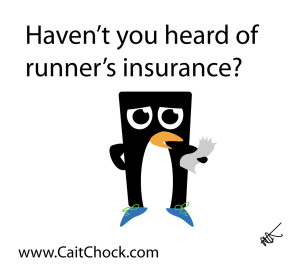
What nugget of wisdom with Mr. Penguin be dropping on us next time?
——-
More running CARTOONS AND LAUGHS
Posts on GI Issues for Runners HERE and HERE
——-
1) What nugget of truth do you think our penguin will be quipping about next time?

.jpeg?picon=3498)
By: Cait,
on 5/25/2014
Blog:
Cait's Write...
(
Login to Add to MyJacketFlap)
JacketFlap tags:
food,
family,
running,
comics,
Cartoons,
motivation,
art,
goals,
nutrition,
Sunday Morning Inspiration,
sunday morning motivation,
sunday mor,
Add a tag
I grew up in a house where my mom HATED to see things go to waste. We were a household who left-over’ed and if we didn’t clean our plates we could usually count on Mommy-O to finish them off. She WAS a runner after all. The thing was, it killed my mother to put food in the trash or down the disposal.
Wasting is, well, a waste.
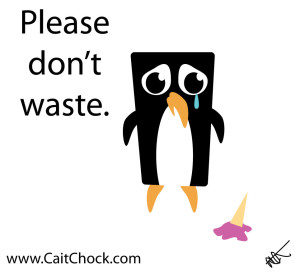
This holds true in life. And with the human body, if you’re even an iota interested in physiology, anatomy, and sports science you’ve got to just take a step back and think, “Holy crap, the body is amazing. Like freaking incredible.” All the complexities, the systems working together, playing off of each other, people can quip the ‘miracle of life’…heck, it’s pretty dang remarkable what goes in to just digesting! Something enters the mouth, get broken down, gives you the energy to run, and then gets pooped out the other end. That’s pretty dang cool!
Not taking advantage of just how amazing and remarkable the human body is, it’s a waste. Obesity, a growing lack of exercise, a growing disinterest…bordering on HATE of activity is a waste, it’s sad. Here is this amazing human body machine…just waiting to DO, to perform.
A body can be worked. It can be run. It can be trained. It can be stressed by training and then, if given the chance to recover, it will GROW, become stronger, tougher, faster, and then eager to achieve even more. Keep doing that and watch how far you can go.
Physiology is quite amazing, don’t forget that. Don’t take it for granted either…PUSH yourself to discover your own potential.
A vehicle left abandoned is waste. Take advantage of the miraculously, mind-blowing things your body can DO and get DOing.

.jpeg?picon=3498)
By: Cait,
on 5/8/2014
Blog:
Cait's Write...
(
Login to Add to MyJacketFlap)
JacketFlap tags:
races,
race tips,
tips,
running,
training,
track,
motivation,
goals,
nutrition,
Add a tag
Now my younger brother’s first love is rugby, second is football, but for the three weeks between seasons he decided to do track! Wahoo…I was stoked!! I’m also in awe of the fact that he doesn’t do any speed-work and then just blitzes those 400′s and 200′s like they’re nothing.

The mystery is solved as to where all of the fast twitch muscle fiber genes in the family went. Clearly all were saved and concentrated into the youngest Chock sibling. Oh and I guess he stole my coordination genes too. 
Granted he’s got the competitiveness of a Chock, so he’ll gut out a race and pay the price after to hit those marks. But the truth is that last 100 of a 400 isn’t fun for anybody, no matter if you’ve trained or not…BLECH…talk about booty lock.
Checking out those high school meets has been fun, observing just as much so, and here are a few tips I’d pass on if teenagers actually cared to listen to us old folks:
* Warm-up and Recovery:
set yourself up to run your best, not warming up before a race is setting yourself up for
both injury and running below your maximum potential. Cold muscles no likey sprinting. The same for after your race, do all you can to recover so you can come back stronger. That includes a cool-down and
refueling within 30 minutes of finishing.
* Drafting and Tangents: it was windy at the track meet and those are days where you really want to draft. Leading expends more mental energy and on windy days it expends a heck of a lot more physical energy to lead. If you can, tuck in behind somebody until you’re really to surge past them. When you DO make your move, try to make it on a straight away…running the tangents on a race course is the same idea, don’t run more than your race distance or your competitors are.
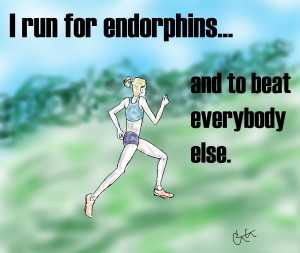
* When You Pass, You PASS: racing is mental like that, when you make a move and pass someone you want to be passing them for good. Conserve energy and then blow by that sucker! Don’t ‘weakly’ pass them because then they can just tuck in behind you and let you do the work. You want to BLOW by them and try to mentally break them. Make them think, “Dang, they’re feeling much stronger than me, I can’t keep up.” Even if you feel like crap, it’s a race, you should feel tired, but your competitors don’t have to know you’re tired as heck and clinging on until the finish line. Break them and leave them in your dust.
* Cling-on: sorry, no sci-fi reference, but this speaks to those getting passed. Read above. You can’t get in the mind of your competitors and chances are they’re working, tired, and hurting too. If they pass you, rally the troops and try to stay with them. Don’t let THEM mentally break you. See, it works two ways like that. 
The last thing I’ll add, while I like to joke that I have not a single fast twitch muscle in my body (I’ve never been biopsied, but I’ll say I probably only do have one!) DON’T use that as an excuse to avoid speed-work. It’s incredible how much you can manipulate and overcome your natural predisposition in terms of speedster versus endurance maven. You’d be surprised that, yes, even ye of one speed can get some wheels on themselves and wind up with really strong kicks.
The thing is you just have to train those muscles! For speed you need to build power (hills, sprints, plyo’s) and all that good stuff is plenty of fodder for another post!
Get out there and kick some butt…embrace the booty lock too! 
——–
Have you checked out my Ezzere Running Tees yet?? Mosey over, folks!!
Send MAJOR cheers to one awesome Kim @ Day with KT this rockstar runnerchick and mom is out to kill it at her 50 mile race this Saturday!! WAHOOOO!!!

Hydration is not something runners can afford to skimp on. Fun fact: by the time you actually FEEL thirsty you’re in a state of dehydration. The key is sipping those fluids consistently, throughout the day, and ensuring you’re urine is rocking the clear-light yellow hue rather than radioactive yellow-orange.
With summer fast approaching and the hotter temps that accompany, it’s important runners are issued a reminder just HOW crucial it is to stay hydrated. If you don’t, your performances will suffer but more importantly it could become dangerous. Dehydration can also wreck havoc on your stomach and intestines.
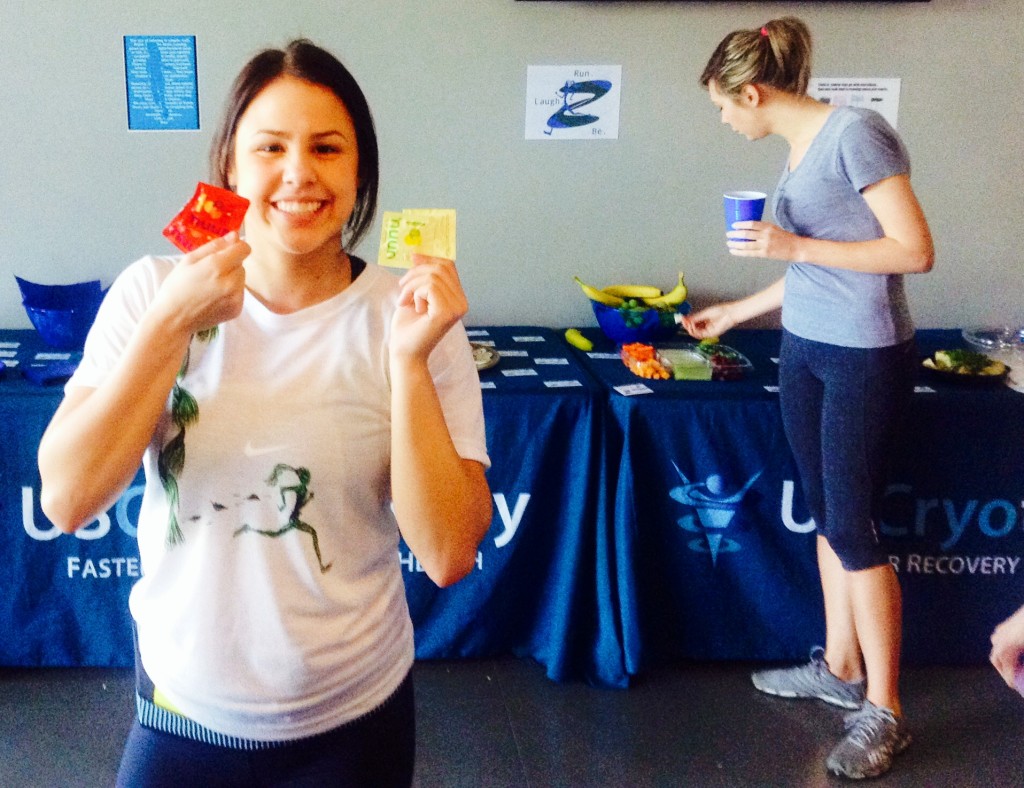
For runners, hydration is more than just drinking water. Water is essential but so are electrolytes. When you sweat you lose more than just H2O; electrolytes, like potassium and sodium, are also lost through sweat and are just as important to replace. When electrolytes get unbalanced, that’s when you run the risk of heart issues and other complications due to an overly dilute blood stream. Not fun. Besides, before you even get to THAT dangerous of a point, your running will be sub-par if you’re not hydrated fully with water AND electrolytes.
Our good friends at Nuun have been supplying those cool tablets that you can drop into your water bottle, shake, and voila have your electrolyte-infused (and tastified) drink for years. They’ve introduced their new Nuun Energy line and I served it at my Ezzere Launch Party even! Nuun was generous enough to give samples to all of my guests and put together a prize pack for this lucky winner…

He’s excited, he’ll never be dehydrated.  Here’s the scoop on the new Nuun Energy:
Here’s the scoop on the new Nuun Energy:
* Electrolytes: These new Nuun tablets have all the essential electrolytes as the pervious Nuun Active Hydration line as well as extra B Vitamins and a bit of caffeine.
* No Sugars: There’s not any extra sugar added, meaning you can replace your electrolytes without tons of excess calories. Each tablet is less than 12 calories which, unless you need immediate glycogen while running a marathon, is what most runners are looking for in this type of hydration performance supplement. Unless you’re needing to gain weight, a common mistake runners can make is drinking too many unnecessary calories by way of sports drink. Namely because of a high sugar content. Not so with Nuun.
* Caffeine: The extra caffeine (40mg) perks you up and certain studies have shown that a small dose of caffeine pre-workout or race can give you a boost there.

The Taste Factor:
I like that Nuun adds a nice flavor to my water but doesn’t turn it into Kool-Aide. It’s not overly sweet. “It’s fizzy!” one of the guests of my Ezzere Launch Party squealed in delight. These new flavors have a cool fizz to them and I liked that, as did my guests.
The new flavors are Wild Berry, Lemon Lime, and Cherry Limeade. My favorite was the Wild Berry. They come in the portable vial which is handy to take anywhere and infuse your water. Thank you, Nuun, for joining my party and donating your new Energy drink!
NO EXCUSES, Runners, you can stay hydrated all day long. Your running will thank you, heck, even normal people need to be conscious of staying hydrated…it’s just when you’re asking your body to perform at its best it’s THAT much more important you give it the fluids and electrolytes it deserves!
——–
Check out my latest Active Article: How to Settle Your Race Day Jitters
SUPER stoked to be able to catch up with David Torrence, he’s killing it this year and only going to be setting more records, so check out my story on him over at RunBlogRun: Records Falling and David Torrence is Hungry


By:
Robin Brande,
on 4/12/2014
Blog:
Robin Brande
(
Login to Add to MyJacketFlap)
JacketFlap tags:
Smoothie Recipe,
Green Smoothie,
Green Smoothie Recipe,
Chocolate Banana Strawberry Green Smoothie,
Chocolate Green Smoothie,
Health,
Recipes,
Nutrition,
Eating,
Wellness,
Add a tag

Chocolate Banana Strawberry Pineapple (Etc.) Green Smoothie
Here’s today’s experiment:
- 1 handful sprouts
- 2 large Swiss chard leaves
- 3 dates
- 4 frozen strawberries
- 1 frozen banana
- 3 frozen pineapple chunks
- 1 heaping Tablespoon peanut butter
- 2 heaping teaspoons cacao
- About 1 cup water (up to the Nutribullet fill line)
Taste review: Looks like a chocolate smoothie, tastes a little more gardeny than that. I started with just half a banana and no dates, and it wasn’t sweet enough. I think I could have gotten by with just one teaspoon of cacao. I’m kind of sick of the taste of dates. Will be looking for other ways to sweeten. But overall, not bad! And very, very filling.
Health review: After just a few days of one green smoothie a day, my skin already looks so much better–healthy and clear in a way it hasn’t for months. And my digestion: wow. I won’t go into detail, but let’s just say it’s meeting my need for spring cleaning.
The key, though, is these smoothies have to taste good. This is a voluntary activity and if it’s not fun I won’t do it. Which is why I’m experimenting with flavors. And why I’m reporting to you about those experiments, so that if you’re in the green smoothie mood, you can do it in an enjoyable, non-punishing way. Because we’re against punishment here on the blog.
Carry on, Greenies!

By:
Robin Brande,
on 4/10/2014
Blog:
Robin Brande
(
Login to Add to MyJacketFlap)
JacketFlap tags:
Food,
Health,
Recipes,
Nutrition,
Eating,
Spring Cleaning,
Smoothies,
How To,
Wellness,
Green Smoothies,
Smoothie Recipe,
Fruit Smoothies,
Green Smoothie Recipe,
Nutribullet,
Recovery Foods,
Sports Recovery Foods,
Spring Cleaning Foods,
Spring Cleaning for Your Body,
Add a tag
As you may have been able to tell from my recent photos and posts, I was skiing up until a few days ago. Just arrived home to the desert where it’s already 92 degrees. It’s a little . . . jarring. Dogs are looking at me like, “What the–?” and while they’re busy shedding as much of their fur as possible–I’ll be able to knit a new Labrador in about a week–I’m taking my own measures to adjust to the almost summer.
It’s a two-phase action plan: Clean my house, clean my body.
Believe it or not, the body part of it is much simpler. All I have to do is switch out of winter eating mode (soups, sandwiches, pastas, sweets, sweets, more sweets) and turn to my old friend the green smoothie.
Also known as Baby Poop.
Why Baby Poop? Because if you saw the way one of my green smoothies has traditionally looked–dark brown, sometimes brownish-red, with hints of green flakes–you’d say, “Yeah, good luck with that, think I’ll have a salad.” But for some reason, I’ve been out of the salad mood for about a year now. Can’t explain it. So I’m just going with it.
The thing that’s going to banish the baby-poopedness look of my smoothies from now on is that tomorrow I’ll be getting this nifty machine that actually has a proper motor. I discovered while skiing that that’s been the whole problem with my green smoothie life. I just haven’t had enough power.
I made that discovery by watching someone else make one for me. The things she put in there! (To be discussed below.) And by the time she poured it into a cup, the liquid was this beautiful, light green, and instead of tasting gritty and *good for me,* it tasted smooth and delicious, more like a dessert. Which, see above re: winter diet, sold me.
But even better, the smoothie fixed me. Day after day I’d stumble into that place, start croaking out ingredients–”Dates! Cashews! Oh my gosh I’m about to pass out–coconut! More fat! Bring it!”–and the lovely proprietoress, Gretchen, would keep adding and adding (see below) and then give me basically a cup full of green medicine.
I have never recovered from a big physical effort more quickly and more deliciously. That’s what I’m saying. That’s why I’m trekking down the Green Smoothie Way.
I’ll be experimenting with new recipes as I go, and I’ll post some of the best ones here, but let’s start with the Skiing Kicked My Butt recipe that got me through:
- Big handful of unsalted cashews
- Normal handful of unsalted sunflower seeds
- One heaping teaspoon peanut butter
- Big handful of dates (about 5)
- One banana, preferably frozen to give the drink some thickness
- Big handful of strawberries, also preferably frozen
- Normal handful of blueberries (optional–makes the color a little weirder, but tastes good)
- Two heaping teaspoons cacao (unsweetened cocoa powder will do) (also optional, but wow)
- One teaspoon coconut (optional, but yum)
- Three huge leaves of kale or Swiss chard, stems and all, ripped into pieces and layered on top
- About 1/2 to 1 cup of peach, pear, or apple juice
- About 1 1/2 cups pure water–start with 1 cup, then add more as you assess the thickness. Some people like their smoothies thicker, some more liquidy. You’re the boss.
I tried this in my regular blender, but no. Baby poop. I’ll take a photo of the proper green smoothie once I try it with my new machine tomorrow. You’ll see. Fresh and spring-looking.
Onward, green smoothiers!
Whether it be sarcasm, pancakes or otherwise, whatever fuels your running must be celebrated.
Power of the Running Snark
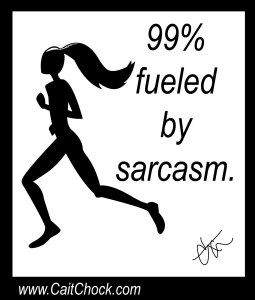
Trust me, a runner’s brain is wont to wander on those long runs and easy days, making jokes is certainly one of the best ways to roll. The perks of being your own running comedian:
* No hecklers: yea, let’s be honest, our brains may be a little deprived of of oxygen mid-run so the jokes may not exactly hold-up on a real comedy tour.
* Free laughs: it’s always MORE than okay to laugh at your own jokes, and out loud. Heck, you could wail like a hyena in the middle of the woods.
* Good times: spot really random moments of people when they have no idea anyone is like finding gold. Runners tend to go unnoticed by normal folk, we just blend into the background, so running is sometimes like the People Watching Olympics.
Running For Pancakes
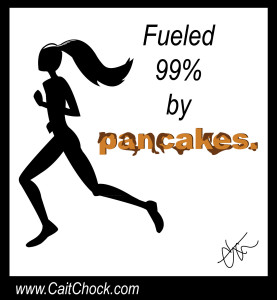
Literal fuel for your running, certainly never to be overlooked. Now the bait reward of the foods to come often spend copious amounts of time on the brain during a run…
* Long run salivation: staring that 22-mile long run? Shall I take a poll as to how many of those miles were spent drooling over just how much you’re going to savor devouring [insert favorite food here] upon return? No judgement if drooling starts the moment the watch starts.
* Pre-food penance: on the flip side, pick the WRONG food before a run and you’ll most likely spend the entirety of that run paying the price. We need to start assigning a Points System for certain foods if ingested before a run: ice cream ands loads of dairy = 15 fart points, super spicy thai = 27 bush-dive points, burrito bomb = 45 clenched cheek shuffle point/27 fart points/39 bush dive points…that may work in making us reeeealllly consider if it’s worth eating that BEFORE we run. 
* Energy: okay, let’s take a moment for a bit of seriousness…use food to fuel your performance people, fuel up right and you’ll feel the benefits. Good news is there aren’t militant expectations, it’s all about balance: ensure you get enough protein, time that protein right, make the majority of your carbs high-quality, eat your fruits and veggies, hydrate well and with electrolytes too, get enough iron and THEN…after that you deserve your desserts, treats, and rewards.
So now I ask, Runners, what’s fueling YOUR runs??
——-
Tips for coming up with a winning running nutrition plan.
How to eat out while still eating to perform…BONUS, that means you CAN eat for ‘fun’ and ‘performance’…hehe. 
More cartoons and humor because, let’s be honest, laughing is the only way to go!
——–
1) Last thing you found hilarious while on the run?
2) What were you thinking about on your last run?
I had this annoying song stuck in my head, and that you just can’t run away from. 
3) What’s one tip when it comes to running and nutrition you like to live by?

Us runners sure do a number on our poor tummies. All the pounding, up, down, fast, jiggling, jiving…if our stomaches and intestines could speak I can only imagine the expletives they’d be yelling at us!
Actually, those stomaches and intestines of runners DO speak…just with things much more powerful, dare I even say explosive, than words. Yes, runners and their guts are stuck in a state of ongoing negotiations.
“PLEASE behave for my long run, preeeettty please!!” the runner’s silent prayer before heading out the door.

Runners plan their foods accordingly, learn from trial and error, we do our best to set ourselves up to avoid a stomach related attack but sometimes it feels like we’re in some kind of peace-treaty contract negotiation House of Cards style.
Those runner guts are testy, moody, volatile. Sometimes there is just NO pleasing them despite what feels like us doing our best to abide by the ‘rules’.
I’ve done a few posts on handling GI issues HERE and HERE
Today let’s talk about those post-run, especially post-workout tummies and guts. After all that jiggling and jiving lots of runners complain of feeling nauseous, that food is the LEAST appealing thing in the world, and sometimes runners actually struggle to keep food down.
The issue is that runners ALSO know how incredibly important refueling your body and muscles is within the first 30 minutes of finishing your workouts. In order to maximize your recovery (upwards of 60% better) so you can come back stronger, it really is crucial to find something, anything that will get into your system and STAY there.
This is an occasion where liquids can be a runner’s best friend. If you struggle with keeping actual food down due to an upset stomach after your runs and hard workouts take it to the liquids. Recovery drinks and smoothies can get you those essential protein amino acids and carbs to repair those muscles.
Recently Clif sent me a care package, among the bars (which I already knew I liked and enjoy), they introduced me to their recovery and electrolyte drinks. I hadn’t tried either of those so was interested to test them out.

Clif Protein Recovery Drink
I sampled the Orange Mango and really liked it. I tried it mixed in with a smoothie (berries and other fruit) and I also tried it just mixed with water. It’s sweet but not overpoweringly so, and plenty tasty on it’s own just with the water.
Each pack has 170 calories and 10 grams of protein. If there was anything I would change or suggest it would be if there were more grams of protein. Ideally, post-run and post-workout you want at least 25 grams of protein. But other than that, I really liked this one…it also comes in Chocolate and while I didn’t try this flavor, really I’ve not met something chocolate I don’t enjoy.
Clif Electrolyte Hydration Drink
These little guys come in tiny sleeves and are really easy to carry around and stash in a bag. I tried the Cranberry Raz and it was a win in the taste department. The thing with hydration for runners is this is an ALL DAY thing, you need to continually be drinking water and fluids…not just right before or after your runs.
I’ve also explained a lot how crucial it is to drink not JUST water, but to find electrolyte replacement drinks to ensure your balances there are correct. Especially with the potassium and sodium. So this is why the market for electrolyte drinks has exploded the past few years. Taste-wise Clif nailed it. The only recommendations I have is that they offer a few with less calories…one pack is 80 calories because it also contains the simple sugars.
If you’re actually RUNNING (ie: part of your marathon training fueling strategy) you DO need that quickly digested glucose. But, if you’re not and you’re just needing the electrolytes the extra carbs and calories may not be what you need.
Thank you, Clif, for sending me these to test out and review!! All their products are available online and I’ve seen them in lots of stores too. 
Soooo, while I STILL feel entitled to complain and be irked at my stomach any and every time it causes me trouble…on some level, when I imagine the bumping, jumping, jiving, and all that other stuff it has to put up with I can kinda sympathize with it for putting up with me as much as it does! 
Treat your stomaches with care, Runners!
1) If you’ve had a dialogue with your stomach how did it go? Do you say a little hope/prayer before long runs?? haha.
2) Something you’ve learned about running and nutrition lately?
3) Have you tried either the Clif Recovery or Electrolyte Drinks?

That long run brought to you by dreams of PaNcAkeS!!! Or insert your favorite post-run food there. Actually, you can swap out the long run for a race. Scratch that you can preeeetty much just swap that out for any run. Any distance…any food. #runners #workforit #reward #bait ??

While us runners certainly can eat more than a football team, amongst those pancakes, Pop-Tarts, burgers, fries, milk shakes, etc…we DO know that in order to run our best we need to fuel our best.
The beautiful thing though, is that eating to PERFORM doesn’t mean you can’t have your cake and eat your apples too. It’s all about balance. There are some KEY elements that all runners in training should be mindful of:
* Protein:
getting enough and timing that intake
* 30 Minute Recovery: eating protein and carbs within 30 minutes of finishing a run
* Healthy Picks: insert your
fruits, veggies, whole grains, quality carbs here
* Vitamins and other nutrients: IRON is sooo important for runners and ensuring they get enough!
* Hydration: it’s crucial runners ensure they drink enough fluids and more than just water,
replacing those electrolytes too
But it’s ALL about balance, and even professional distance runners are allowed their cookies and burgers too. Hey, when you’re burning all dem calories you earn those treats!
This post comes in step with my latest article over on Running Times: “The Power of Protein Timing”
Good luck to all those racing, and to everyone else go out there and get your run on…enjoy every sweaty mile!! 
——–
More posts all about how to eat to fuel your running and preform your best HERE!
Highlighting living in the real world and eating post: “How runners can stuff their faces at restaurants but still perform at their best”
More Cartoons and laughs HERE!
Tomorrow are the USA Cross Champs and here is one more recent article highlighting HTS Elite runners there tomorrow: RunBlogRun – Taking Boulder Back: HTS Elite looks to make this the distance runner’s power city once again
——–
1) What’s your ‘drool dream’ food while running?
2) How do you keep track of your protein intake and ensuring you get enough?
3) How do you track your fruits and veggies and make sure you’re getting enough?

There’s a little beast that lives inside every runner. He gets really irritable after long runs. He’ll yell, he’ll scream, he’ll kick, he’ll throw a full on Toddlers and Tiaras style tantrum until you give him what he wants. He’s screaming, “FEEEEED ME!!!!”
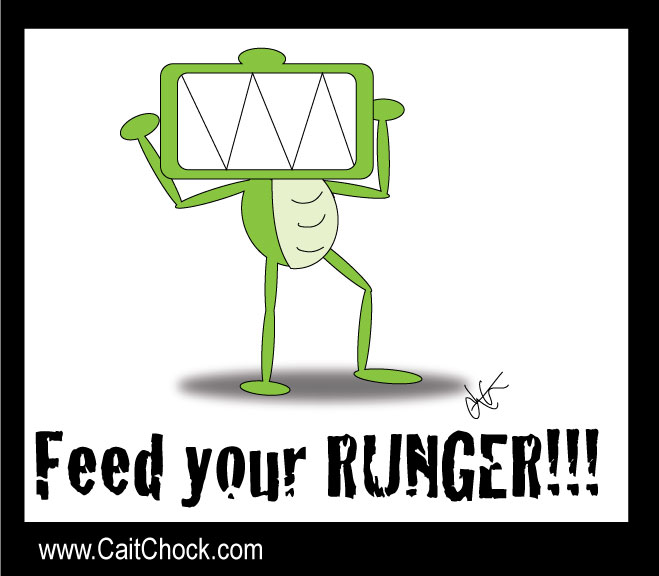
Yup, that’s your Runger talking. Shut him up. Feed the beast! 
Runger’s an interesting thing, as is sports nutrition. It’s a tricky topic because running burns tons of calories so naturally runners need to EAT more. At the same time, what we fuel our bodies with has a direct correlation to its performance. Add in that every runner’s metabolism and body type is different and things can get kinda hairy, scary monstrous.
So getting back to Runger? Here are some more quick facts about our little belly-dwelling man:
* Running and Appetite: Exercise requires more energy, so duh, runners need more calories [energy] than the sofa-surfers of the world. Input versus output. Ideally everyone could eat intuitively, but food is such a cultural/emotional/past-time, growing up people tend to lose touch with their ‘intuition’ when it comes to hunger and fullness.
* Feeding Runger ASAP: The key to speeding up your muscle recovery, and to help quell the Runger beast from yelling at you so loud later that you over-eat, is to refuel RIGHT after you finish a run or workout. That 30 minute recovery window is critical! Get your protein and carbs in before you even shower!
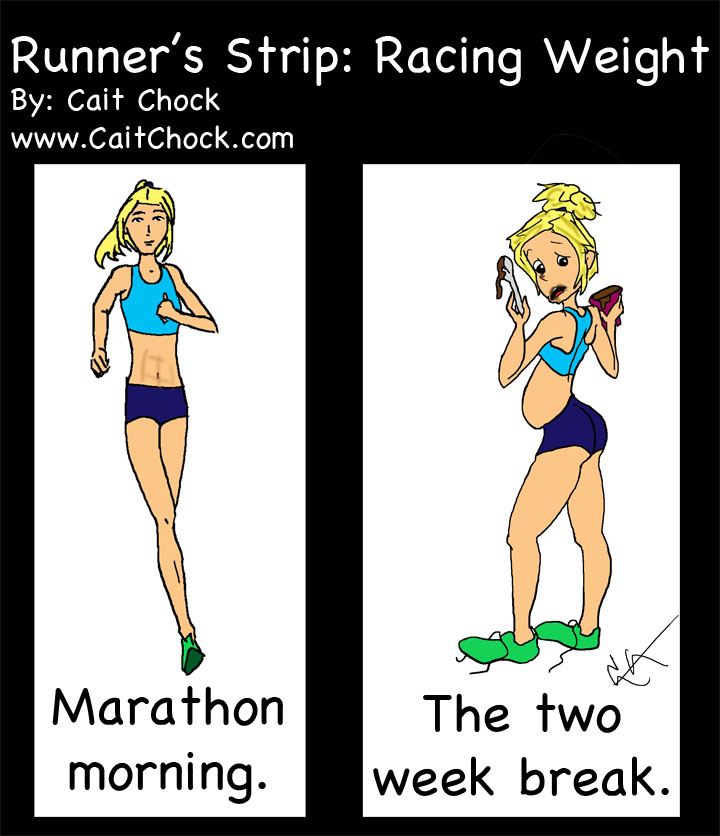
* Marathon Weight Gain? Lots of new runners jump straight to a marathon and think, “Hey, I bet I’ll lose weight!” The irony is that a good portion of those runners notice they GAIN weight and are puzzled. Why? Runger, Baby, Runer. Easy runs and long runs especially kick up the appetite of a person, incidentally the body doesn’t have a totally accurate gauge between the amount of calories burned running and then amount of calories it wants to eat. Probably a survival mode thing that’s outdated. What that means is after those long runs your hunger level will probably leave you wanting to inhale more calories than you actually burned.
* Female Runger: It sucks but the whole mistaken gauge of amount of running in respect to level of hunger is more skewed for women. So women tend to get even hungrier than men after the same run, so can wind up, again, taking in more than they need.
* Speedwork: The irony to the people who sign up for a marathon JUST TO lose weight, is that they would be better off doing shorter races and speedwork. Why? Harder workouts tend to suppress the appetite after and they also kick your metabolism up more than easy runs and they also keep it elevated hours after the hard run.
Taming Runger Tips:
* Protein!
Not only do you need protein to build and repair your muscles but protein is also going to really help with satiation; it will keep you feeling fuller longer. If you’re finding yourself insanely insatiable you probably need more protein.
* Eat Fast: Not the rate of your eating, but you need to eat sooner rather than later. Meaning eat when you’re not on the verge of feeling like your stomach is sucking up against your spine, wait too long and you’ll be too famished. Again, another reason to refuel as soon after your runs as possible.
* Eat Healthy: Fiber will help fill you up, so get lots of fruits and veggies in there. Good for straight-up health but also, 10 apples are way more filling than 10 Cheetos. Who can eat just 10 Cheetos??
Gaining Weight:
I said how every runner is different, well the cruel irony is that some runners are constantly trying to tame their Runger in a way to avoid gaining weight, while other runners are constantly fighting to keep weight on. For those with speedy bullet metabolisms:
* Liquids: Fluids don’t fill you up like foods do, so adding liquid calories are super easy. Good choices are milk, smoothies, and protein shakes.
* Calorie Dense: Think the opposite of the 10 apples thing, look for foods that have more calories in smaller portions. Examples: peanut butter, avocados, cheese, nuts, ice cream!! 
* Healthy then Plus: Just because you need more calories doesn’t mean good nutrition goes out the window. I liken it to the healthy+plus method. I tend to have a faster metabolism so I make sure to get my healthy stuff (fruits, veggies, enough protein) in and THEN I use whatever more calories I need as ‘fun foods.’ Totally inhale your cakes but don’t neglect your apples type of thinking.
Whew, I think we covered a lot about that hungry little gremlin dwelling in your stomach. All that food talk probably woke him up….if so, avoid Pinterest or Instagram. 
——-
More posts on RUNNER NUTRITION HERE
——-
1) How do you balance healthy eating with Runger?
2) What kind of runs tend to leave you the most famished?
3) If you’re trying to gain weight, what are some of your go-to foods/liquids?

“If you’ve got an issue, here’s a tissue.” Certainly that fits with the ‘runner mentality’ for many things. Intervals hurt, well, they’re going to hurt until we finish all the repeats.
Long runs are…long. Yup, that’s how it goes. Just keep telling yourself to make it one more mile, one more mile, etc…until your done!
Then the legs start having their issues. They’ll start begging for their own tissues. The way to stave off some total toddler-level tantrums from the legs are to supply them their tissues on a consistent basis BEFORE their demands are too high.

Runner bones are just, well, better bones. 
. Don’t go into a workout with ‘cold’ legs. Don’t immediately blast like a bat out of he**, your legs like a little warning. “We’re going to workout now”…gradually lower into the pace and you’ll feel better, wind up running faster, and avoid the lactic acid booty-lock shuffle home.
* Tissue 2: Stretching. Yea, stretching is NEVER as much fun as running but if you want to run better you need to be loose. You’ve got to have the flexibility to open up your stride, you want as much range of motion as possible. So suck it up, get your stretching and yoga time in, your legs will thank you with faster times AND less injuries.
* Tissue 3: Massage. Look, I’ll be honest and say I’m as not-rich as the next person, so I self-massage regularly but I’m ALSO re-learning how imperative it is to see a professional massage therapist when I can. Running is pretty abusive on the body and to un-do some of that damage you need that massage work. Look at it as an investment in YOURSELF. Namely your sanity (my sanity hinges upon my endorphin fix) because the longer you run the more important it is to get that tissue work. Well, that is if you’d like to keep running for the rest of your life. [Side-note, I'll be doing another post on this later but my massage therapist of choice is Al Kupczak in Boulder, CO...Boulder Body Therapy. He's a massage GOD. Works on Olympians and us mortal runners alike.]
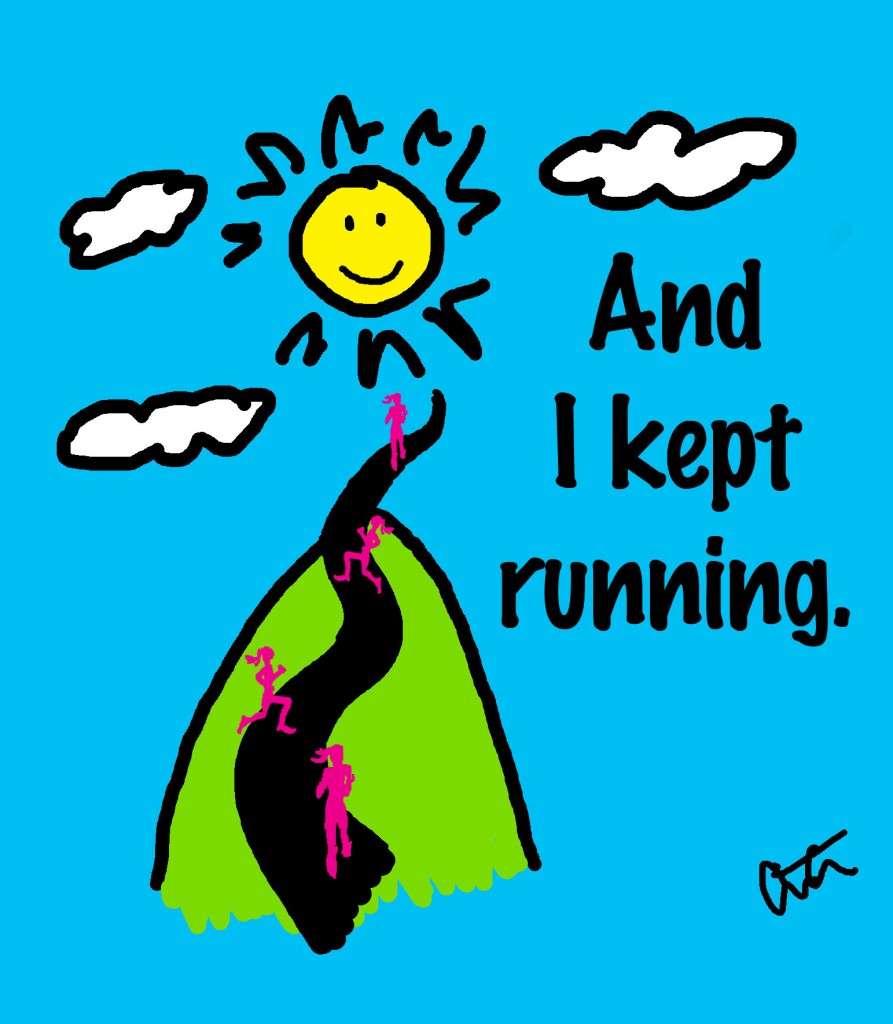
* Tissue 4: Proper pacing. I guess this more fittingly could be said as separating your easy and hard days. Run your easy days EASY. Scr*w the pace and run for effort, whatever effort that allows you to recover. Then, come your hard days you’ll have the bounce to go fast. Also recognize the difference between a workout and a race. Come race day you want to elevate to that next level, that’s tough to do if you’re redlining ever.single.hard.workout. Got it? Well, race day is also boosted by the mental energy and excitement, but still, don’t race all of your workouts, People, mmmmk?
* Tissue 5: Refuel. Said it zillions of times…hit that 30 minute post-workout recovery window. Get 20-25 grams of protein and some carbs into your system to jumpstart muscle recovery, repair, and regrowth. That way your legs will come back feeling better and stronger for your next run, your next workout, your next race.
The body of a runner is constantly crying and complaining. What a pain the butt, right?  Thankfully we’re mentally tough BUT we’ve also got to be smart enough to give our complaining legs and muscles their pre-emptive tissues to at least limit their tantrums.
Thankfully we’re mentally tough BUT we’ve also got to be smart enough to give our complaining legs and muscles their pre-emptive tissues to at least limit their tantrums.
—–
Running ‘tough’ is a yin-yang sort of thing, my last post is all about how being ‘tough’ isn’t always about running through the pain or pushing. Being smart and all that.
—–
1) Do you have a tissue to add?
2) How often do you see a professional massage therapist?
GO VISIT AL! 
3) How good are you at hitting the 30 minute refuel window?

View Next 25 Posts

























Why study the South? What makes this peculiar region important from the point of views of Americans, or people abroad wanting to know more about the American experience? The South experienced changes and phenomena central to how the United States evolved over time.
The post How the South was made appeared first on OUPblog.